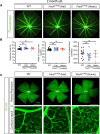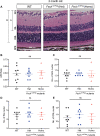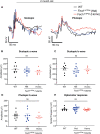Retinal Phenotyping of Ferrochelatase Mutant Mice Reveals Protoporphyrin Accumulation and Reduced Neovascular Response
- PMID: 33620374
- PMCID: PMC7910629
- DOI: 10.1167/iovs.62.2.36
Retinal Phenotyping of Ferrochelatase Mutant Mice Reveals Protoporphyrin Accumulation and Reduced Neovascular Response
Abstract
Purpose: Heme depletion, through inhibition of ferrochelatase (FECH), blocks retinal and choroidal neovascularization. Both pharmacologic FECH inhibition and a partial loss-of-function Fech mutation (Fechm1Pas) are associated with decreased neovascularization. However, the ocular physiology of Fechm1Pas mice under basal conditions has not been characterized. Here, we aimed to characterize the retinal phenotype of Fechm1Pas mice.
Methods: We monitored retinal vasculature at postnatal day 17, 2 months, and 6 months in Fechm1Pas homozygotes, heterozygotes, and their wild-type littermates. We characterized Fech substrate protoporphyrin (PPIX) fluorescence in the eye (excitation = 403 nm, emission = 628 nm), retinal function by electroretinogram, visual acuity by optomotor reflex, and retinal morphology by optical coherence tomography and histology. We stained vasculature using isolectin B4 and fluorescein angiography. We determined endothelial sprouting of retinal and choroidal tissue ex vivo and bioenergetics of retinal punches using a Seahorse flux analyzer.
Results: Fundi, retinal vasculature, venous width, and arterial tortuosity showed no aberrations. However, VEGF-induced retinal and choroidal sprouting was decreased in Fechm1Pas mutants. Homozygous Fechm1Pas mice had pronounced buildup of PPIX in the posterior eye with no damage to visual function, bioenergetics, and integrity of retinal layers.
Conclusions: Even with a buildup of PPIX in the retinal vessels in Fechm1Pas homozygotes, the vasculature remains normal. Notably, stimulus-induced ex vivo angiogenesis was decreased in Fechm1Pas mutants, consistent with reduced pathologic angiogenesis seen previously in neovascular animal models. Our findings indicate that Fechm1Pas mice are a useful model for studying the effects of heme deficiency on neovascularization due to Fech blockade.
Conflict of interest statement
Disclosure:
Figures






References
-
- Bonkovsky HL, Guo JT, Hou W, Li T, Narang T, Thapar M.. Porphyrin and heme metabolism and the porphyrias. Compr Physiol. 2013; 3: 365–401. - PubMed
-
- Boulechfar S, Lamoril J, Montagutelli X, et al. .. Ferrochelatase structural mutant (Fechm1Pas) in the house mouse. Genomics. 1993; 16: 645–648. - PubMed
Publication types
MeSH terms
Substances
Grants and funding
LinkOut - more resources
Full Text Sources
Other Literature Sources
Medical
Molecular Biology Databases

